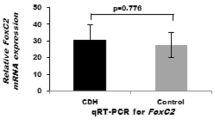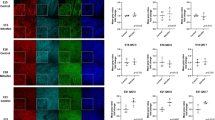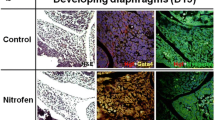Abstract
Purpose
The high mortality in congenital diaphragmatic hernia (CDH) is mainly attributed to pulmonary hypoplasia. Recent studies suggest that retinoid signaling pathway (RSP) is inhibited in the nitrofen-induced hypoplastic lung. The insulin-like growth factor (IGF) system plays a crucial role in fetal lung development by interaction of IGFBP-3 and IGFBP-5 with RSP. We hypothesized that pulmonary IGFBP-3 and IGFBP-5 gene expression levels are downregulated in the nitrofen-induced pulmonary hypoplasia.
Methods
Pregnant rats were exposed to either olive oil or 100 mg nitrofen on day 9.5 (D9.5) of gestation. Fetal lungs were harvested on D18 and D21 and divided into control and nitrofen groups. IGFBP-3 and IGFBP-5 pulmonary gene and protein expression were determined using real-time RT–PCR and immunohistochemistry.
Results
Relative levels of IGFBP-3 mRNA were significantly decreased in the nitrofen group (8.00 ± 14.44) in D21 compared to controls (14.81 ± 16.11; p < 0.05). Expression levels of IGFBP-5 mRNA were also significantly decreased in nitrofen group (10.66 ± 4.83) on D18 compared to controls (17.92 ± 4.77). Immunohistochemistry showed decreased IGFBP-3 expression on D21 and decreased IGFBP-5 immunoreactivity on D18 in hypoplastic lungs compared to controls.
Conclusion
Downregulation of IGFBP-3 and IGFBP-5 gene expression may cause pulmonary hypoplasia in the nitrofen-induced CDH model by interfering with retinoid signaling pathway.

Similar content being viewed by others
Explore related subjects
Discover the latest articles and news from researchers in related subjects, suggested using machine learning.References
Torfs C, Curry C, Bateson TF et al (1992) A population-based study of congenital diaphragmatic hernia. Teratology 46:555–565. doi:10.1002/tera.1420460605
Bohn D (2002) Congenital diaphragmatic hernia. Am J Respir Crit Care Med 166:911
Puri P (1994) Congenital diaphragmatic hernia. Curr Prob Surg 31:787–846
Dillon P, Cilley R, Mauger D et al (2004) The relationship of pulmonary artery pressure and survival in congenital diaphragmatic hernia. J Pediatr Surg 39:307–312
Iritani I (1984) Experimental study on embryogenesis of congenital diaphragmatic hernia. Anat Embryol 169:133–139. doi:10.1007/BF00174435
Tenbrick R, Tibboel D, Gaillard J et al (1990) Experimentally induced congenital diaphragmatic hernia in rats. J Pediatr Surg 25:426–429
Noble B, Babiuk R, Clugston R (2007) Mechanism of congenital diaphragmatic hernia-inducing teratogen nitrofen. Am J Physiol Lung Cell Mol Physiol 293:L1079. doi:10.1152/ajplung.00286.20071040-0605/07
Kluth D, Kangah R, Reich P et al (1990) Nitrofen induced diaphragmatic hernia in rats: an animal model. J Pediatr Surg 25:850–854
Zachman RD (1995) Role of vitamin A in lung development. J Nutr 125:1634S–1638S
Smith S, Dickman E, Power S et al (1998) Retinoids and their receptors in vertebrate embryogenesis. J Nutr 128:467S–470S
Zile M (2001) Function of vitamin A in vertebrate embryonic development. J Nutr 128:455S–485S
Zile M (1998) Vitamin A and embryonic development: an overview. J Nutr 128:455S–458S
Greer J, Babiuk R, Thebaud B (2003) Etiology of congenital diaphragmatic hernia: the retinoid hypothesis. Pediatr Res 53:726–730. doi:10.1203/01.PDR.0000062660.12769.E6
Price WA, Stiles AD (2000) The insulin-like growth factor system and lung. In: Mendelson CR (ed) Endocrinology of the lung. Humana Press Inc, Totowa, pp 201–208
Ricort J-M (2004) Insulin-like growth factor binding protein (IGFBP) signaling. Growth Horm IGF Res 14:277–286. doi:10.1016/j.ghir.2004.02.002
Retsch-Bogart GZ, Moats-Staats BM, Howard K et al (1996) Cellular localization of messenger RNAs for insulin-like growth factors (IGFs), their receptors and binding proteins during fetal rat lung development. Am J Respir Cell Mol Biol 14:61–69
Pavelic J, Matijevic T, Knezevic J (2007) Biological & physiological aspects of action of insulin-like growth factor peptide family. Indian J Med Res 125:511–522
Liu B, Lee H-Y, Weinzimmer SA et al (2000) Direct functional interaction between insulin like growth factor binding protein-3 and retinoid X receptor alpha regulate transcriptional signaling and apoptosis. J Biol Chem 275:33607–33613. doi:10.1074/jbc.M002547200
Schedlich LJ, Young TF, Firth SM et al (1998) Insulin-like growth factor binding protein (IGFBP)-3 and IGFBP-5 share a common nuclear transport pathway in T47D human breast carcinoma cells. J Biol Chem 273:18347–18352
Chen M, MacGowan A, Ward S et al (2003) The activation of the retinoic acid response element is inhibited in an animal model of congenital diaphragmatic hernia. Biol Neonate 83:157–161. doi:10.1159/000068932
Mey J, Babiuk R, Clugston R et al (2003) Retinal dehydrogenase-2 is inhibited by compounds that induce congenital diaphragmatic hernias in rodents. Am J Pathol 162:673–679
Nakazawa N, Montedonico S, Takayasu H et al (2007) Disturbance of retinol transportation causes nitrofen induced hypoplastic lung. J Pediatr Surg 42:345–349. doi:10.1016/j.jpedsurg.2006.10.028
Montedonico S, Nakazawa N, Puri P (2006) Retinoic acid rescues lung hypoplasia in nitrofen-induced hypoplastic foetal rat lung explants. Pediatr Surg Int 22:2–8. doi:10.1007/s00383-005-1571-x
Kimura Y, Suzuki T, Kaneko C et al (2002) Retinoid receptors in the developing human lung. Clin Sci 103:613–621
Author information
Authors and Affiliations
Corresponding author
Rights and permissions
About this article
Cite this article
Ruttenstock, E., Doi, T., Dingemann, J. et al. Downregulation of insulin-like growth factor binding protein 3 and 5 in nitrofen-induced pulmonary hypoplasia. Pediatr Surg Int 26, 59–63 (2010). https://doi.org/10.1007/s00383-009-2509-5
Published:
Issue Date:
DOI: https://doi.org/10.1007/s00383-009-2509-5




